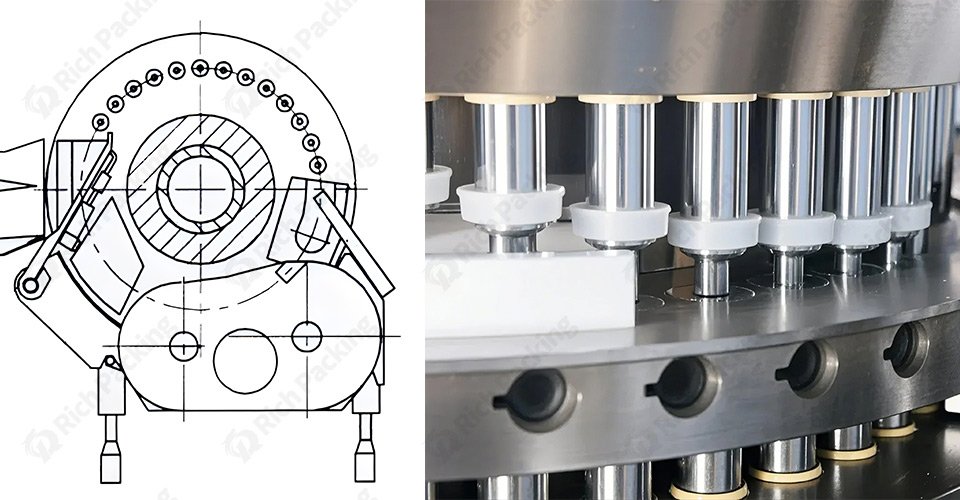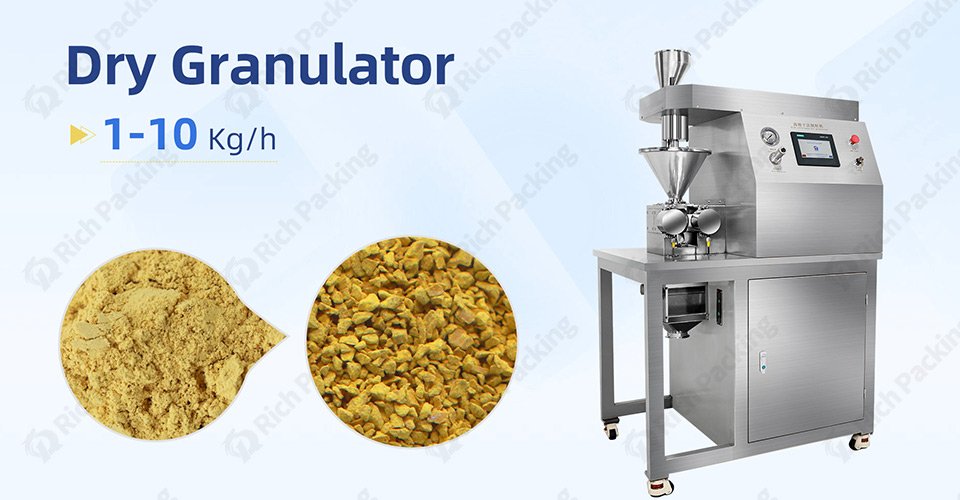Khi bạn bước vào thế giới sản xuất dược phẩm, máy ép viên là một thiết bị quan trọng giúp biến bột thành những viên nén chính xác và đồng nhất. Chiếc máy này không chỉ là một cỗ máy — Đây là trung tâm của quá trình sản xuất viên nén, chịu trách nhiệm chuyển đổi các hợp chất dược phẩm thô thành thuốc giúp cải thiện và cứu sống con người.

Máy dập viên là một thiết bị cơ học được thiết kế để nén các nguyên liệu dạng bột thành những viên nén có kích thước, hình dạng và trọng lượng đồng đều. Về cơ bản, đây là một cỗ máy tinh vi, có chức năng nghiền các thành phần bột rời thành dạng dược phẩm rắn, dễ tiêu thụ, thu hẹp khoảng cách giữa nguyên liệu thô và thành phẩm thuốc.
Chức năng chính của máy ép viên
- Đo chính xác lượng bột
- Nén bột thành hình dạng xác định trước
- Đảm bảo trọng lượng và mật độ viên nén đồng đều
- Sản xuất viên nén có đặc tính giải phóng đặc hiệu

Phễu đóng vai trò là cửa ngõ đầu tiên để đưa nguyên liệu vào quy trình ép viên. Nó đóng vai trò quan trọng trong việc quản lý dòng chảy của nguyên liệu bột, đảm bảo nguồn cung cấp ổn định và kiểm soát cho các khoang khuôn. Bằng cách ngăn ngừa các vấn đề như tắc nghẽn nguyên liệu và duy trì dòng bột ổn định, phễu đóng vai trò thiết yếu trong việc đạt được sản lượng viên nén đồng đều.
Chức năng chính của hệ thống phễu
- Lưu trữ nguyên liệu bột thô
- Đảm bảo dòng bột chảy đều
- Ngăn ngừa vật liệu bị bắc cầu hoặc bị thủng

Bàn khuôn là trái tim cơ khí cốt lõi của máy dập viên. Nền tảng xoay này chịu trách nhiệm chứa nhiều khoang khuôn và điều phối quy trình phức tạp tạo viên thuốc. Khả năng quay liên tục và thiết kế chính xác của nó cho phép biến đổi bột rời thành viên thuốc có hình dạng hoàn hảo, quyết định năng suất sản xuất chung và hiệu quả của quy trình sản xuất.
Chức năng chính của bàn khuôn
- Xoay liên tục trong máy ép viên quay
- Chứa được nhiều khoang khuôn
- Cung cấp cơ chế chính cho quá trình hình thành viên nén
- Xác định năng lực sản xuất chung

Lắp ráp khuôn đột và khuôn dập
Linh kiện được thiết kế chính xác này chính là nơi phép màu tạo nên viên thuốc thực sự diễn ra. Các đầu đột trên và dưới hoạt động hoàn hảo, tạo hình, nén và tạo hình viên thuốc với độ chính xác cực kỳ cao. Được chế tác từ thép tôi cứng, những linh kiện này quyết định mọi đặc điểm quan trọng của viên thuốc thành phẩm, từ trọng lượng, độ dày đến mật độ và tính toàn vẹn về cấu trúc.
Chức năng chính
- Đục trên và đục dưới tạo nên hình dạng của viên thuốc
- Được thiết kế chính xác đến mức dung sai cực nhỏ
- Xác định trọng lượng, độ dày và mật độ của viên thuốc
- Được làm từ thép cứng cho độ bền cao

Các loại máy ép viên
Máy ép viên nén không phải là loại máy phù hợp với mọi quy mô sản xuất, mà là thiết bị chuyên dụng được thiết kế để đáp ứng các nhu cầu sản xuất khác nhau. Hai loại máy ép viên nén chính, mỗi loại đều có những ưu điểm riêng, phù hợp với quy mô và yêu cầu sản xuất khác nhau.
|
Tính năng |
Máy ép viên nén một lỗ |
Máy ép viên quay |
|
Quy mô sản xuất |
Quy mô nhỏ |
Khối lượng lớn |
|
Chế độ hoạt động |
Thủ công hoặc bán tự động |
Hoàn toàn tự động |
|
Ứng dụng điển hình |
Nghiên cứu và phát triển, lô nhỏ |
Sản xuất dược phẩm công nghiệp |
|
Viên nén mỗi phút |
Hàng chục đến hàng trăm |
Hàng ngàn |
|
Đầu tư ban đầu |
Thấp hơn |
Cao hơn |
|
Độ phức tạp |
Đơn giản |
Trình độ cao |
Nén trực tiếp là phương pháp đơn giản nhất trong sản xuất viên nén. Phương pháp này bao gồm việc nén trực tiếp các thành phần dạng bột mà không cần thêm bất kỳ bước xử lý nào, lý tưởng cho các hợp chất nhạy nhiệt. Thành công phụ thuộc rất nhiều vào các tá dược được lựa chọn cẩn thận, giúp tạo điều kiện nén đồng đều và tạo thành viên nén.
Được thiết kế đặc biệt cho các vật liệu nhạy cảm với độ ẩm, tạo hạt khô cung cấp một phương pháp chuyên biệt để ép viên nén. Quy trình này bao gồm việc nén bột thành khối đặc mà không cần pha loãng với chất lỏng, do đó ngăn ngừa các tương tác hóa học tiềm ẩn. Bằng cách duy trì các đặc tính ban đầu của bột đồng thời cải thiện khả năng nén, tạo hạt khô mang đến một giải pháp quan trọng cho các công thức dược phẩm khó.

Phương pháp nén phức tạp nhất, tạo hạt ướt Đưa chất kết dính lỏng vào vật liệu bột, tạo hạt bằng cách bổ sung độ ẩm có kiểm soát. Kỹ thuật này cải thiện đáng kể đặc tính chảy của bột và tăng cường tính toàn vẹn cấu trúc của viên nén. Mặc dù đòi hỏi nhiều công sức hơn, tạo hạt ướt mang lại khả năng kiểm soát tuyệt vời đối với các đặc tính vật lý và hóa học của viên nén thành phẩm.

Việc áp dụng lực nén là một sự cân bằng tinh tế, ảnh hưởng trực tiếp đến hiệu suất của viên nén. Lực nén thấp tạo ra viên nén dễ vỡ với tốc độ hòa tan tăng nhưng độ bền cơ học giảm. Ngược lại, lực nén cao tạo ra viên nén cứng hơn với độ bền cơ học được cải thiện nhưng khả năng hòa tan có thể chậm hơn.
Hiểu rõ đặc tính của bột là yếu tố then chốt cho sự thành công của quy trình sản xuất viên nén. Các yếu tố như phân bố kích thước hạt, độ ẩm, đặc tính chảy, khả năng nén và độ kết dính ảnh hưởng trực tiếp đến mọi giai đoạn hình thành viên nén. Những đặc tính phức tạp này không chỉ quyết định quy trình sản xuất mà còn quyết định chất lượng, hiệu suất và hiệu quả cuối cùng của sản phẩm dược phẩm.
Quá trình ép viên thuốc tiềm ẩn nhiều biến chứng. Các vấn đề về dòng chảy bột có thể dẫn đến việc nạp liệu không đồng đều và quá trình đổ khuôn không đều. Các vấn đề về nén có thể dẫn đến sự thay đổi trọng lượng, độ cứng không đồng đều, kẹt khí và các biến chứng liên quan đến ma sát. Các nhà sản xuất thành công phải phát triển các chiến lược chẩn đoán và tối ưu hóa tinh vi để vượt qua những thách thức cố hữu này.
Công nghệ nén viên nén là phần cốt lõi của quy trình sản xuất dược phẩm, nơi bột nguyên liệu được chuyển thành viên nén đồng đều, chất lượng cao bằng máy dập viên chính xác. Từ máy dập viên nén một lần đến máy dập viên nén quay, các phương pháp nén khác nhau và kiểm soát chính xác các thông số chính đảm bảo chất lượng, độ ổn định và hiệu quả của thuốc, phản ánh bản chất khoa học và chính xác của công nghệ dược phẩm.